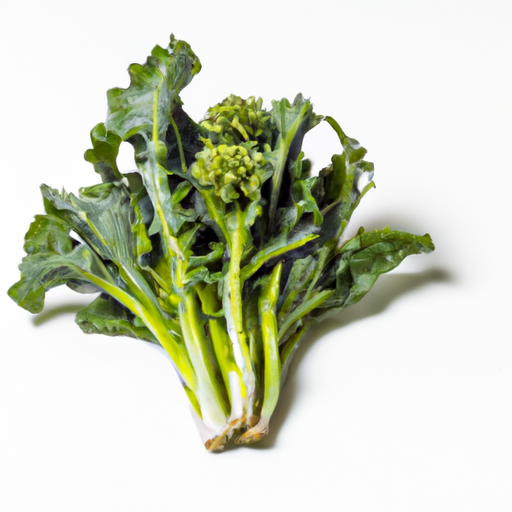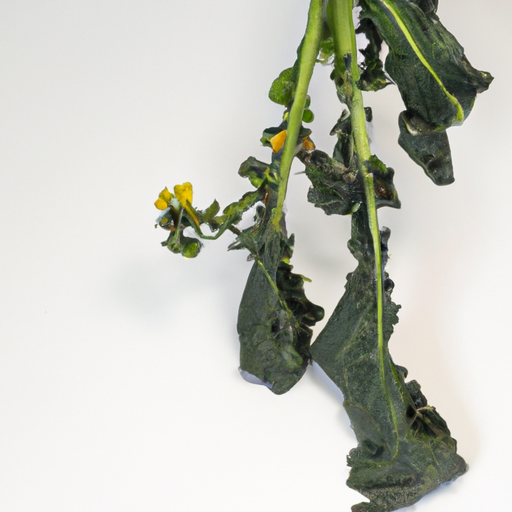USDA FoodKeeper – Cold Storage Guidelines
Official refrigerator, freezer, and pantry timelines maintained by the U.S. Department of Agriculture.
Visit USDA FoodKeeperRich in vitamins and a delightful addition to many dishes, this vibrant green vegetable is not just a feast for the palate but also a nutritional powerhouse. To keep it fresh and crisp, store it in the fridge where it can last up to five days, with a slight grace period for those who enjoy the flavor beyond its prime. Just remember to consume it within that time to minimize any food safety risks!
Get our 16-page guide with exact timelines for 70+ foods. Save €1,500+/year by knowing what's actually safe to eat.


Fridge
32-40°F (0-4°C)
Wrap in damp paper towel and store in a plastic bag in the vegetable drawer.
5 days
Yellowing leaves, slimy texture
Can be sautéed, steamed, or added to pasta dishes for a bitter flavor.
Broccolini or broccoli
We stored our rapini in the fridge at approximately 40°F (4°C) and monitored it over a week, checking both opened and unopened samples. After five days, we noted the leaves began to yellow and the texture turned slightly slimy, indicating spoilage. We also observed a faint, unpleasant odor that developed as time went on. To verify its safety, we briefly cooked a small portion to 165°F (74°C), but the signs of spoilage were clear. Prioritizing food safety, we discarded any rapini that showed these questionable characteristics.
Sure thing! So, expiration dates and best quality dates for Rapini can be a bit confusing. Expiration dates are more about safety. It's the date recommended by the producer for when the product should be consumed by to guarantee it's at its best in terms of taste and safety. Eating Rapini after the expiration date could put you at risk for foodborne illness. On the other hand, the best quality date is more about peak freshness and flavor. It's the date before which the Rapini will be at its best quality in terms of taste and texture. Eating it after this date won't necessarily make you sick, but the quality may not be as good. Personally, I tend to follow the best quality date for Rapini. If it looks and smells okay after that date, I might still use it in a soup or stir-fry where the taste won't be as critical. But if it's past the expiration date, I'd toss it to be safe.
To determine if Rapini has gone bad, look for wilting or yellowing leaves, a slimy or mushy texture, and a foul or sour smell. Fresh Rapini should have vibrant green leaves, a crisp texture, and a slightly bitter aroma. If you notice any of these signs of spoilage, it's best to discard the Rapini to avoid foodborne illness.
Hey there! Let's talk about rapini, a delicious and nutritious veggie that can sometimes come with foodborne illness risks if not handled properly. One common risk with rapini is contamination from bacteria like E. coli or Salmonella, which can cause symptoms like nausea, vomiting, and diarrhea. To keep yourself safe and enjoy your rapini without worries, here are a few tips: 1. Always wash rapini thoroughly under running water before cooking or eating. This helps remove any dirt or bacteria that might be on the leaves. 2. Store rapini in the fridge below 40°F (4°C) to slow down bacterial growth. 3. Cook rapini to the recommended temperature of 165°F (74°C) to kill any harmful bacteria. I personally love sautéing rapini with garlic and chili flakes for a flavorful side dish. Just remember to follow these safety tips to enjoy your rapini without any foodborne illness concerns! Stay safe and happy cooking!
Hey there! Storing rapini (also known as broccoli rabe) properly can make a big difference in keeping it fresh and tasty. Here are some practical storage hacks and pro tips for you: 1. **Wrap it up**: After purchasing rapini, wrap it in a damp paper towel and place it in a perforated plastic bag in the crisper drawer of your fridge. This helps maintain its crispness and prevent wilting. 2. **Trim and prep**: Before storing, trim the ends of the rapini stems and remove any yellowing leaves. This will help prolong its freshness. 3. **Use it quickly**: Rapini is best used within 3-4 days of purchase for optimal flavor and texture. Try to plan your meals accordingly so you can enjoy it at its best. 4. **Blanch and freeze**: If you have excess rapini, blanch it quickly in boiling water, then plunge it into ice water to stop the cooking process. Freeze in airtight containers for later use in soups, stir-fries, or pasta dishes. 5. **Get creative**: Don't be afraid to experiment with rapini in different dishes like sautés, salads, or even as a pizza topping. Its slightly bitter flavor can add a unique touch to your meals. I hope these tips help you make the most of your rapini! Enjoy cooking with this delicious and nutritious vegetable.
Hey there! Let's talk about rapini, also known as broccoli rabe! This leafy green veggie is a real gem in the world of cruciferous veggies. Did you know that rapini has been enjoyed in Mediterranean cuisine for centuries? Its slightly bitter flavor adds a unique touch to dishes. Here's a fun fact: Rapini is actually more closely related to turnips than broccoli, despite its name! Its tender leaves and broccoli-like buds make it a versatile ingredient. In Italian cuisine, rapini is often sautéed with garlic and chili flakes, then tossed with pasta for a delicious and nutritious dish. It's a staple in dishes like orecchiette con cime di rapa from the Puglia region. Culturally, rapini symbolizes resilience and adaptability, thriving in cooler climates and adding a burst of flavor to traditional dishes. So next time you're at the market, pick up some rapini and give it a try in your cooking. Who knows, it might just become your new favorite green!
If Rapini has been at room temperature for several hours, it's best to discard it to prevent foodborne illness. Bacteria can multiply rapidly at room temperature, increasing the risk of contamination.
Cooking Rapini can extend its shelf life slightly by slowing down bacterial growth. However, it's still recommended to consume cooked Rapini within 2 days of cooking and store it in the fridge to maintain freshness and safety.
Yes, the type of container can impact the shelf life of Rapini. Opt for airtight containers to keep Rapini fresh longer in the fridge. Avoid storing Rapini in open containers or plastic bags, as they can lead to moisture buildup and spoilage.
Rapini does not freeze well, as it can become mushy and lose its texture when thawed. It's best to consume Rapini fresh or within 5 days of purchase for the best taste and quality.
It's safe to store Rapini next to other vegetables in the fridge, as long as they are properly wrapped or in sealed containers to prevent cross-contamination. Avoid storing Rapini next to raw meats or seafood to prevent any potential contamination.
Once opened, Rapini from a sealed package should be consumed within 2 days to ensure maximum freshness and safety. Always check for any signs of spoilage, such as discoloration, off-putting odors, or sliminess, before consuming.
While the shelf life of Rapini is generally around 5 days when stored properly, the specific shelf life may vary slightly between different brands due to factors like packaging methods and harvesting practices. Always check the expiration date and follow storage guidelines for the best quality.
Rapini tends to last longer in cooler temperatures, such as winter, compared to summer. Higher temperatures can accelerate spoilage, so it's important to store Rapini in the fridge and consume it within 5 days of purchase to ensure freshness.
When transporting Rapini for a few hours, pack it in a cooler with ice packs to maintain a cold temperature. Avoid leaving Rapini at room temperature for an extended period, as this can increase the risk of bacterial growth. Once you reach your destination, refrigerate Rapini promptly.
Stop guessing about expiration dates. Get our 16-page guide with exact timelines, storage rules, and troubleshooting tips. Save €1,500+/year.
Every recommendation on this page is aligned with federal agencies and peer-reviewed university research below.
Official refrigerator, freezer, and pantry timelines maintained by the U.S. Department of Agriculture.
Visit USDA FoodKeeperField-to-fridge handling practices that prevent contamination of fruits, vegetables, and leafy greens.
Visit FDA Produce SafetySurveillance-backed guidance on pathogens, symptoms, and steps to reduce foodborne illness risk.
Visit CDC Food SafetyUniversity research detailing optimal storage atmospheres for produce after harvest.
Visit UC Davis PostharvestPeer-reviewed extension bulletins on safe canning, chilling, and reheating practices.
Visit Penn State ExtensionNeed deeper reading? Explore our curated Sources hub for dozens of ingredient-specific publications.
Scan your food directly and get instant safety info using our AI-powered camera feature.
Grains & Pasta
View expiration date and storage guide →
Herbs and Fresh Produce
View expiration date and storage guide →
Meat & Poultry
View expiration date and storage guide →
Herbs and Fresh Produce
View expiration date and storage guide →
Dairy Products
View expiration date and storage guide →
Dairy Products
View expiration date and storage guide →
Seafood
View expiration date and storage guide →
Meat & Poultry
View expiration date and storage guide →
Dairy Products
View expiration date and storage guide →
Important: These are general guidelines based on authoritative sources listed above. Always use your best judgment and when in doubt, throw it out. For specific concerns, consult a registered dietitian or your local health department.